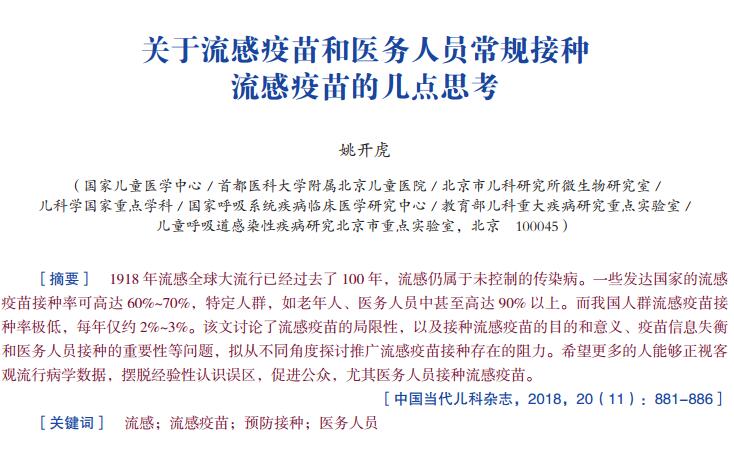 PDF(1087 KB)
PDF(1087 KB)


Some thoughts on influenza vaccine and regular influenza vaccination for healthcare workers
YAO Kai-Hu
Chinese Journal of Contemporary Pediatrics ›› 2018, Vol. 20 ›› Issue (11) : 881-886.
 PDF(1087 KB)
PDF(1087 KB)
 PDF(1087 KB)
PDF(1087 KB)
Some thoughts on influenza vaccine and regular influenza vaccination for healthcare workers
It has been 100 years since the 1918 influenza pandemic but influenza is still an uncontrolled infectious disease. In some developed countries, the coverage rate of influenza vaccine can reach as high as 60%-70%, and even up to 90% or higher in some specific population, such as the elderly and healthcare workers. The coverage rate of influenza vaccination in Chinese people, however, is very low, only about 2%-3% per year. The limitations of influenza vaccine, and the purpose and significance of influenza vaccination, the imbalance of vaccine information and the importance of inoculation for healthcare workers are discussed in this paper. The resistance to popularize influenza vaccination is explored from different perspectives. It is hoped that more people will recognize the objective epidemiological data, and get rid of misunderstandings based on their experiences. Healthcare workers in particular, and the general population, should be encouraged to have an influenza vaccination.

Influenza / Influenza vaccine / Vaccination / Healthcare worker
[1] The Lancet Infectious Diseases. How to be ready for the next influenza pandemic[J]. Lancet Infect Dis, 2018, 18(7):697.
[2] Plotkin SA, Orenstein WA, Offit PA. 疫苗[M]. 罗凤基, 杨晓明, 王军志, 等, 译. 第2版. 北京:人民卫生出版社, 2016:388-443.
[3] Jorgensen P, Mereckiene J, Cotter S, et al. How close are countries of the WHO European Region to achieving the goal of vaccinating 75% of key risk groups against influenza? Results from national surveys on seasonal influenza vaccination programmers, 2008/2009 to 2014/2015[J]. Vaccine, 2018, 36(4):442-452.
[4] Centers for Disease Control and Prevention. Flu vaccination coverage, United States, 2016-17 influenza season[EB/OL].[2018-07-28]. https://www.cdc.gov/flu/fluvaxview/coverage-1617estimates.htm.
[5] Yang J, Atkins KE, Feng L, et al. Seasonal influenza vaccination in China:Landscape of diverse regional reimbursement policy, and budget impact analysis[J]. Vaccine, 2016, 34(47):5724-5735.
[6] Richman DD, Whitley RJ, Hayden FG. 临床病毒学[M]. 陈敬贤, 周荣, 彭涛, 等, 译. 第3版. 北京:科学出版社, 2012:950-984.
[7] 疾病预防控制局. 传染病预防控制[EB/OL].[2018-07-25]. http://www.moh.gov.cn/jkj/s2907/new_list.shtml.
[8] 国家统计局. 中华人民共和国2017年国民经济和社会发展统计公报[EB/OL].[2018-02-28]. http://www.stats.gov.cn/tjsj/zxfb/201802/t20180228_1585631.html.
[9] Weekly US. Influenza Surveillance Report[EB/OL].[2018-07-30]. https://www.cdc.gov/flu/weekly/index.htm.
[10] Central Intelligence Agency. The World Factbook[EB/OL].[2018-07-30]. https://www.cia.gov/library/publications/theworld-factbook/geos/us.html.
[11] Smith AM, Huber VC. The unexpected impact of vaccines on secondary bacterial infections following influenza[J]. Viral Immunol, 2018, 31(2):159-173.
[12] Kwong JC, Schwartz KL, Campitelli MA, et al. Acute myocardial infarction after laboratory-confirmed influenza infection[J]. N Engl J Med, 2018, 378(4):345-353.
[13] Clar C, Oseni Z, Flowers N, et al. Influenza vaccines for preventing cardiovascular disease[J]. Cochrane Database Syst Rev, 2015(5):CD005050.
[14] 尤拉·比斯. 免疫[M]. 彭茂宇, 译. 桂林:广西师范大学出版社, 2016:171.
[15] 冯录召, 杨鹏, 张涛, 等. 中国季节性流感疫苗应用技术指南(2014-2015)[J]. 中华流行病学杂志, 2014, 35(12):1295-1319.
[16] National Center for Immunization and Respiratory Diseases, CDC; Centers for Disease Control and Prevention (CDC). Use of influenza A (H1N1) 2009 monovalent vaccine:recommendations of the Advisory Committee on Immunization Practices (ACIP), 2009[J]. MMWR Recomm Rep, 2009, 58(RR-10):1-8.
[17] Song Y, Zhang T, Chen L, et al. Increasing seasonal influenza vaccination among high risk groups in China:Do community healthcare workers have a role to play?[J]. Vaccine, 2017, 35(33):4060-4063.
[18] 杨君胜, 张丽杰, 冯录召, 等. 青海省西宁市医院临床医护人员2016-2017年度流感疫苗接种情况及影响因素分析[J]. 中华流行病学杂志, 2018, 39(8):1066-1070.
[19] Zhou L, Su Q, Xu Z, et al. Seasonal influenza vaccination coverage rate of target groups in selected cities and provinces in China by season (2009/10 to 2011/12)[J]. PLoS One, 2013, 8(9):e73724.
[20] 唐纳德·普罗西罗. 美国的痛点:科学如何威胁我们的未来[M]. 李芳, 译. 北京:电子工业出版社, 2015:393.
[21] 方格子. 一百年的暗与光:中国麻风防治浙江记录[M]. 杭州:浙江文艺出版社, 2016:65.
[22] Blanco N, Eisenberg MC, Stillwell T, et al. What transmission precautions best control influenza spread in a hospital?[J]. Am J Epidemiol, 2016, 183(11):1045-1054.
[23] Amodio E, Restivo V, Firenze A, et al. Can influenza vaccination coverage among healthcare workers influence the risk of nosocomial influenza-like illness in hospitalized patients?[J]. J Hosp Infect, 2014, 86(3):182-187.
[24] Hayward AC. Influenza vaccination of healthcare workers is an important approach for reducing transmission of influenza from staff to vulnerable patients[J]. PLoS One, 2017, 12(1):e0169023.
[25] Kuster SP, Shah PS, Coleman BL, et al. Incidence of influenza in healthy adults and healthcare workers:a systematic review and meta-analysis[J]. PLoS One, 2011, 6(10):e26239.
[26] 黄徐, 任谦, 李慧明, 等. 医务人员健康状况及相关因素分析[J]. 重庆医学, 2017, 46(12):1663-1665.
[27] 中华人民共和国卫生和计划生育委员会. 2013中国卫生统计年鉴[EB/OL].[2018-07-30]. http://www.nhfpc.gov.cn/htmlfiles/zwgkzt/ptjnj/year2013/index2013.html.
[28] Pereira M, Williams S, Restrick L, et al. Healthcare worker influenza vaccination and sickness absence-an ecological study[J]. Clin Med (Lond), 2017, 17(6):484-489.
[29] Office of Disease Prevention and Health Promotion. Immunization and infectious diseases[EB/OL].[2018-07-30]. https://www.healthypeople.gov/2020/topics-objectives/topic/immunization-and-infectious-diseases/objectives.
[30] 国家药品监督局. 国家药品监督管理局关于长春长生生物科技有限责任公司违法违规生产冻干人用狂犬病疫苗的通告(2018年第60号)[EB/OL]. (2018-07-15)[2018-07-23]. http://cnda.cfda.gov.cn/WS04/CL2050/329592.html.
[31] 姚开虎, 贾举. 加强百日咳研究和防控,维护公众疫苗接种信心——关注效价指标不合格疫苗事件及其长期影响[J]. 中国当代儿科杂志, 2018, 20(1):1-4.
[32] Di Pietro ML, Poscia A, Teleman AA, et al. Vaccine hesitancy:parental, professional and public responsibility[J]. Ann Ist Super Sanita, 2017, 53(2):157-162.